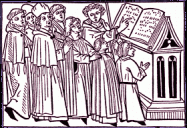How to position a schola
-
OK this reveals my relative ignorance in choral matters, and the answer “it depends” also works; you can only work with the physical space given.
But what goes into the formation which you use to sing chant (particularly the propers) and where you stand? Or what would you do if all things were equal and you had total freedom?
— some directors prefer more of a semi-circle or even a U.
— others have more of a circle (particularly with four to eight or so singers)
— some directors stand in front of the semi-circle, at a small lectern or stand or holding their score. Others are in the semi-circle at the middle point (again, with or without a lectern — I notice that if the schola sings from a giant score, the conductor tends to sing in the middle)
— do you change for the Ordinary or other things where the schola doesn’t carry all the weight?
We are extremely space-limited but are trying new things, and I am noticing that somehow it’s better for my listening with people distributed in a wide semi-circle versus a circle.
There is also the conundrum of Vespers, or the Ordinary in a monastery or seminary, which ideally is sung by people in two parallel lines (and two or more rows potentially on either side).
I have drawn examples of what I mean.
 Conductor schola schematic.pdf117K
Conductor schola schematic.pdf117K -
it is essential that the schola be able to see your chironomy even if only with peripheral vision... we have a schola of 8 at most, so for us, what i have found is
standing in front of an arc works well
standing in the circle works fairly well
standing in middle of an arc doesn't work
our group is too small to do the parallel lines, but I would wonder about the ability of the singers to hear each other (?), which is another essential
Thanked by 1cesarfranck -
Well, the choir posture with parallel lines is practical, and I would only do it for the office. I think that it works well enough, but it can be disconcerting if you find yourself on one end (either end at the Triduum or at a simple office, the end farthest from the altar especially otherwise) in a different way than being in an arc.
Right, seeing the gesture is necessary; let’s assume that we can see it equally well. -
some historic

 91KPRMNdO5L._AC_SX148_SY213_QL70_.jpg148 x 151 - 9K
91KPRMNdO5L._AC_SX148_SY213_QL70_.jpg148 x 151 - 9K
 99f7f150b48a53b5e93ee687aa51c35c.jpg375 x 382 - 38K
99f7f150b48a53b5e93ee687aa51c35c.jpg375 x 382 - 38K
 618xdhebdgL._UXNaN_FMjpg_QL85_.jpg500 x 500 - 74K
618xdhebdgL._UXNaN_FMjpg_QL85_.jpg500 x 500 - 74K
 gregoriano2012_clip_image001_0000.gif295 x 277 - 65K
gregoriano2012_clip_image001_0000.gif295 x 277 - 65K
 unnamed.gif280 x 192 - 36K
unnamed.gif280 x 192 - 36K -
The parking lot would be a good place for some I have heard.
-
-
A question I always had ... and it comes to me again when I look at the pictures posted by @francis: Why are traditional choir stands two-sided? It seems they are typically used only on one side (unlike four-sided stands in some eastern churches where I have seen pictures of monks standing in a circle around it).
-
@smt I suspect 2 reasons,
1. Building a stand to support those rather large and heavy books would be rather difficult, so to avoid having a weak joint, build a two sided triangular stand. It will be much stronger.
2. Also if you are singing antiphonally you could have two books one each side.
Also a Triangular stand would look so much better side on.Thanked by 1smt -
Why are traditional choir stands two-sided?
The other side has the ICEL translation -
Many stands swivel, and some even have 3 or 4 sides: Kyriale, Graduale, Sequentiary &c were different books before the LU innovators and one of the cantors was responsible for opening the next volume to the appropriate page.
-
Because if you don’t “stand” for something you’ll fall for everything.Thanked by 1CharlesW
-
In a church that has excellent acoustics it doesn’t matter which way you face when you’re singing… the whole of the space will be filled with glorious music… and believe me, you don’t need to know the exact words that are being sung… your spirit will comprehend the majesty of God, which goes beyond our finite mind.Thanked by 1tomjaw
-
The singers should know them, though.
-
lol
-
Here's a creative approach - call it the Vox Humana - that saves space:
https://www.youtube.com/watch?v=8sLNOhA7C2QThanked by 1CharlesW
Welcome to the MusicaSacra Forum!
To participate in the discussions on Catholic church music, sign in or register as a forum member, The forum is a project of the Church Music Association of America.
Categories
- All Discussions21,058
- General Music Discussion8,195
- Job Openings191
- Management of Music Programs850
- Choral Matters532
- Church Documents and Rubrics524
- CMAA Notes300
- Events712
- For Newcomers: Read First26
- Sacred Polyphony546
- Hymnody871
- Gregorian Chant: General2,694
- ↳ Graduale Romanum and Liber Usualis367
- ↳ Graduale Simplex60
- ↳ Semiology63
- Vernacular Plainsong695
- Anglican Use and Anglican Chant69
- Organ, Other Instruments and Repertoire434
- New Composition/Works in Progress1,287
- Recordings229
- Music for Hispanic Ministry159
- Music Education: Children211
- Music Education: General222
- News Items245
- Positions Wanted2
- General Discussion: Catholicism738
- Amusements176
- General Discussion1,033
- Opinions117

